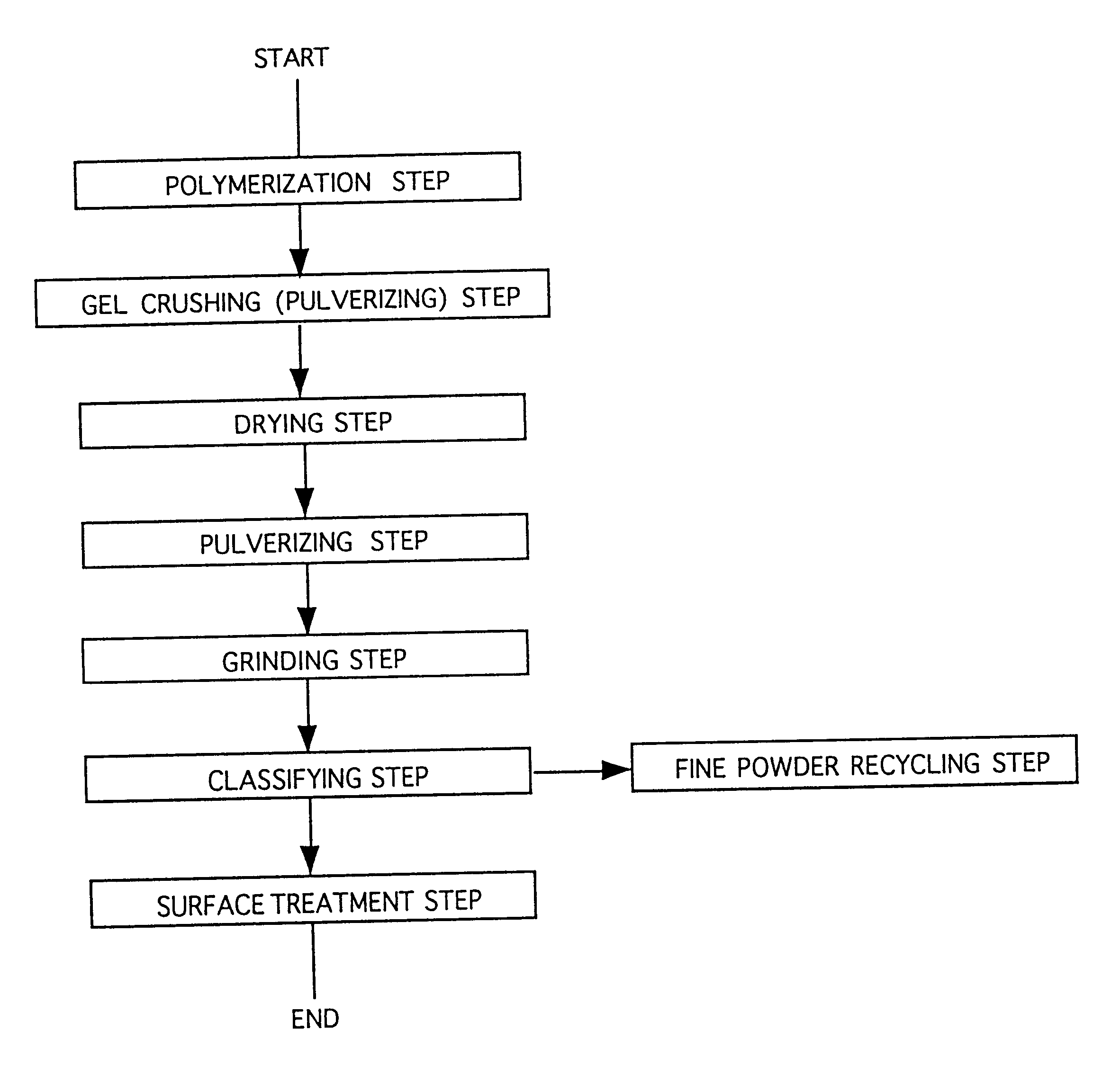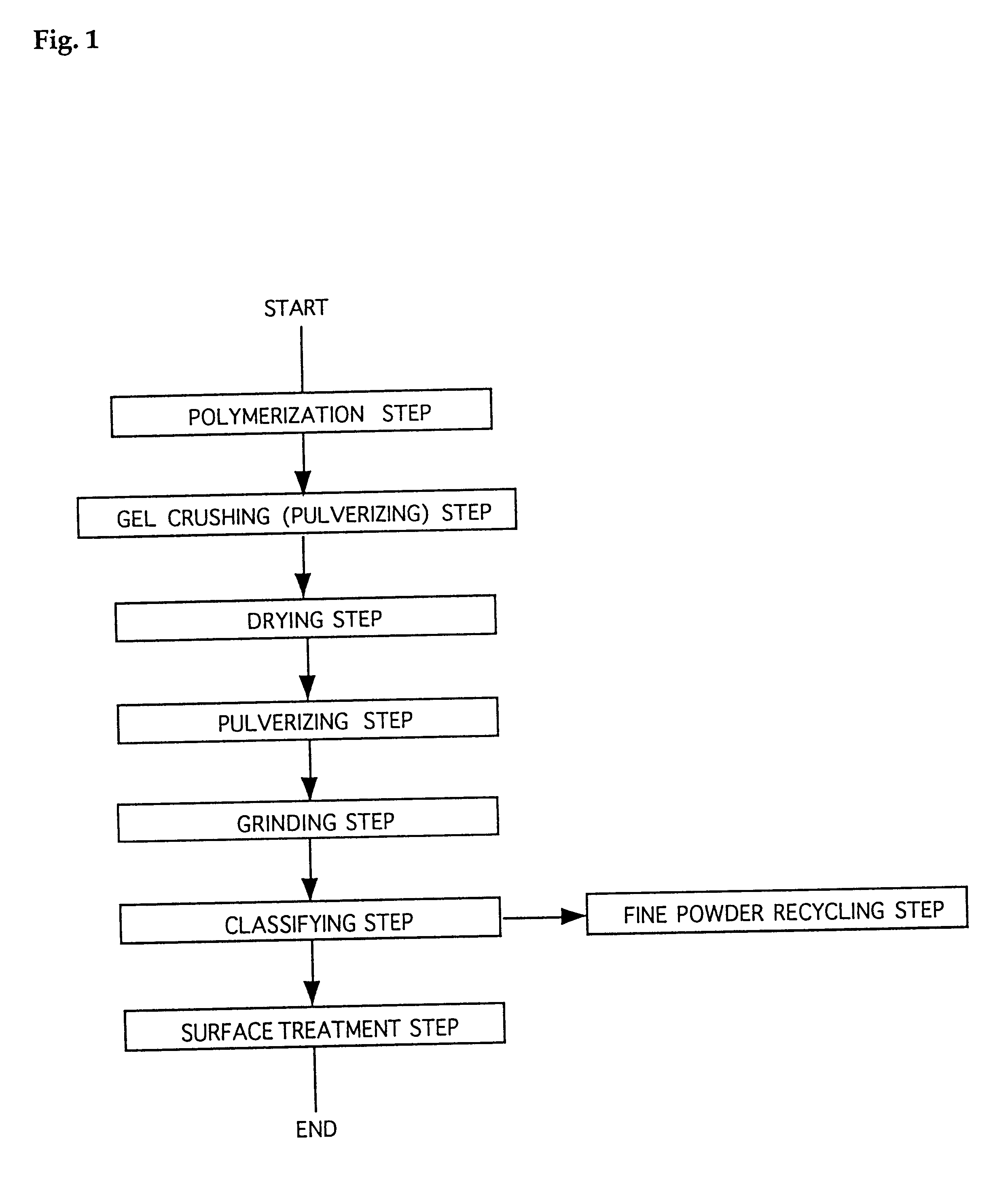Water-absorbent resin powder and its production process and use
a technology of water-absorbent resin and resin powder, which is applied in the field of water-absorbent resin powder, can solve the problems of non-uniform liquid-permeable spaces between particles in absorbent structures or articles, and achieve the effects of enhancing liquid permeability, high water absorption, and strengthening mechanical resistan
- Summary
- Abstract
- Description
- Claims
- Application Information
AI Technical Summary
Benefits of technology
Problems solved by technology
Method used
Image
Examples
referential example 1
In a reaction vessel as prepared by capping a jacketed stainless double-arm type kneader of 10 liters in capacity having two sigmoidal vanes, 2.4 g of ammonium persulfate and 0.12 g of L-ascorbic acid were added to a reaction solution under stirred conditions, wherein the reaction solution was prepared by dissolving 2.50 g of polyethylene glycol diacrylate into 5,500 g of an aqueous solution of sodium acrylate having a neutralization ratio of 75 mol % (monomer concentration: 33 weight %). As a result, about 1 minute after, a polymerization reaction started. Then, while the resultant gel is crushed, the polymerization reaction was carried out in the range of 30.about.80.degree. C., and the resultant hydrogelled crosslinked polymer (1) was got out 60 minutes after the initiation of the polymerization reaction.
The resultant hydrogelled crosslinked polymer (1) had a finely divided diameter of about 5 mm. This finely divided hydrogelled crosslinked polymer (1) was spread onto a wire gauz...
referential example 2
In a reaction vessel as prepared by fitting a stainless vat with a thermometer and a cap, 3.24 g of 5 weight % aqueous sodium persulfate solution, 2.92 g of 0.5 weight % aqueous L-ascorbic acid solution, 3.24 g of 5 weight % aqueous 2,2'-azobis(2-amidinopropane) dihydrochloride (trade name: V-50, made by Wako Pure Chemical Industries, Ltd.) solution, and 3.34 g of 0.35 weight % aqueous hydrogen peroxide solution were added to a reaction solution under stirred conditions, wherein the reaction solution was prepared by dissolving 1.97 g of polyethylene glycol diacrylate into 2,000 g of an aqueous solution of sodium acrylate having a neutralization ratio of 65 mol % (monomer concentration: 35 weight %), and the reaction solution was degassed with nitrogen. As a result, about 1 minute after, a polymerization reaction started. Then, the polymerization reaction was carried out while the lower face of the reaction vessel was cooled to 10.degree. C., with the result that the reaction system ...
referential example 3
In a reaction vessel as prepared by fitting a stainless vat with a thermometer and a cap, 5.33 g of 20 weight % aqueous sodium persulfate solution and 3.20 g of 0.5 weight % aqueous L-ascorbic acid solution were added to a reaction solution under stirred conditions, wherein the reaction solution was prepared by dissolving 4.33 g of polyethylene glycol diacrylate into 2,000 g of an aqueous solution of sodium acrylate having a neutralization ratio of 70 mol % (monomer concentration: 39 weight %), and the reaction solution was degassed with nitrogen. As a result, about 4 minutes after, a polymerization reaction started. Then, the polymerization reaction was carried out while the lower face of the reaction vessel was cooled to 15.degree. C., with the result that the reaction system reached the peak temperature (93.degree. C.) of the heat generation in 16 minutes after the initiation of the polymerization reaction. Then, after heating the lower face of the reaction vessel at 80.degree. C...
PUM
| Property | Measurement | Unit |
|---|---|---|
| Percent by mass | aaaaa | aaaaa |
| Percent by mass | aaaaa | aaaaa |
| Pressure | aaaaa | aaaaa |
Abstract
Description
Claims
Application Information
 Login to View More
Login to View More - R&D
- Intellectual Property
- Life Sciences
- Materials
- Tech Scout
- Unparalleled Data Quality
- Higher Quality Content
- 60% Fewer Hallucinations
Browse by: Latest US Patents, China's latest patents, Technical Efficacy Thesaurus, Application Domain, Technology Topic, Popular Technical Reports.
© 2025 PatSnap. All rights reserved.Legal|Privacy policy|Modern Slavery Act Transparency Statement|Sitemap|About US| Contact US: help@patsnap.com



